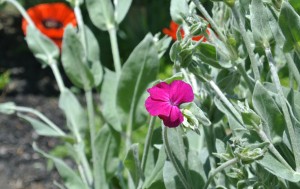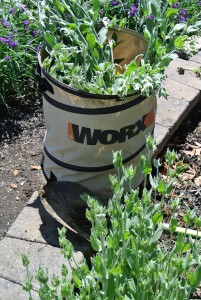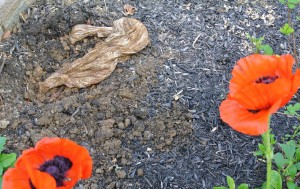Such a beautiful Saturday in May, a brisk wind, temps in the sixties, irresistible gardening weather.
What to do, what to do. Weeding. Pruning, General cleanup.
We are coming up on the 8th anniversary of our moving in. In August of 2005 things looked pretty drab. The slick clay slope behind resisted growth of anything but weeds. The front was pretty barren except for the terrible choices of plant material arbitrarily installed wherever the aesthetically challenged workers stuck them. Since then we have invested an unconscionable amount of money on hardscaping, plants, mulch and fencing, and countless hours of sweat and toil.
Actually, things are looking pretty good, except for the mistakes. There are a lot of mistakes.
Planting mistakes come in three categories: stuff the deer destroy; stuff that simply won’t grow; and stuff that becomes an invasive weed. We’ve learned a lot about what items are on this ruminant’s menu—and there is darned little that isn’t. Our “soil,” should one so dignify it, is a clay and stone matrix—except in the protected woodland which is a clay-and-water swamp, the ecosystem of which was forced precipitously into change, meaning that too many of the trees and shrubs are drowning and all kinds of invasive nuisances are thriving. Then there are the “successes” that have transformed pride into dismay.
We’re working on those.
This morning I decided that the end had come for the rose campion (Lychnis coronaria). It’s a lovely plant, easy to grow, with fuzzy silver-green foliage and magenta flowers. It’s actually a European native, popular in English gardens by the 17th century. Thomas Jefferson logged it in his Garden Book, noting “Lychnis in bloom” at his boyhood home of Shadwell in 1767. In 1807 Jefferson bought seed from Bernard McMahon in Philadelphia.
I am second to none in my admiration for Jefferson’s botanical research and experiments, but this one is a loser in my book. It naturalizes like kudzu and litters the landscape with its spawn. I dug up the plants in the border on one of the terraces, and uprooted seedlings all over the place. (I suspect it will be a while before all the seedlings are eradicated.)
Already underway is the golden raintree attack. Before we even moved here we had received free seedlings from the Arbor Day Foundation. Who doesn’t want to support an organization dedicated to planting trees? It did not occur to us that the Arbor Day Fooundation might be sending us stealth weeds; we coddled the seedlings and planted the survivors.
Golden raintree (Koelreuteria elegans) is a pretty specimen with graceful reticulated foliage and lovely flowers. But Oh My God does it perpetuate itself widely and prolifically. Damn baby trees are showing up everywhere. We sawed down the smallest tree—the other two are slated for destruction.
Then there is the ongoing problem with Empress trees (Paulownia tomentosa). Introduced to the United States from China in 1840, it has a nice moment in late spring when it is covered in fragrant lavender flowers, but the thing grows at an incredible rate of speed and sends up new trees from its roots. Once it gets started it takes over, crowding out all the trees that one might actually want—oak, beech, sycamore, birch, gum, black willow, pretty much anything native to this area. These pests are hydra and every time you cut down a trunk or lop a branch, five or six more emerge to take its place. Going to consult our tree guy on these.
Intending to see if foxglove might be successful in the same location, we headed to the Perennial Farm. We ended up with way more than foxglove, of course, and as I was waiting to check out, I discovered I was standing next to a former president of the Maryland Horticultural Society. I conceded that my garden was pretty much of a mess and she was sympathetic. I mentioned my intent to eradicate good plants gone bad and mentioned a particular pink flower. “Oenothera?” she inquired. (It’s also known as evening primrose.) “You have to be willing to dig a DMZ around them every year unless you want them showing up inside your house.”
Yikes. DMZ is just so Viet Nam. Given the way that oenothera has taken over that terrace, their days are numbered.
Once home we unloaded foxglove, swamp milkweed (Asclepius incarnata), cinnamon fern, a flat of lily-of-the-valley (Convallaria majalis) and a selection of groundcovers. The lily-of-the-valley needs to leaf out a bit, so that will live on the patio for a while. I dug in a couple of ground covers and the swamp milkweed; the foxgloveFmore was to replace the rose campion. I got a couple of plants in then my shovel encountered something resilient and problematic. I kept digging and found—yes!—more trash buried since our first year of home ownership. I am confounded by the amount of garbage interred by Gemcraft (a company who built this subdivision and from whom I would never buy another house) as well as landscapers who later worked on the property. This particular hunk of detritus was, I am pretty sure, shrinkwrap from the blocks used to build that terrace. I got most but not all of it out. For all I know the ends are still clinging to the bottommost stones.
Have to call that particular landscaper anyway about steps he built that are beginning to sag. Even the newest house wants to be a fixer-upper.



